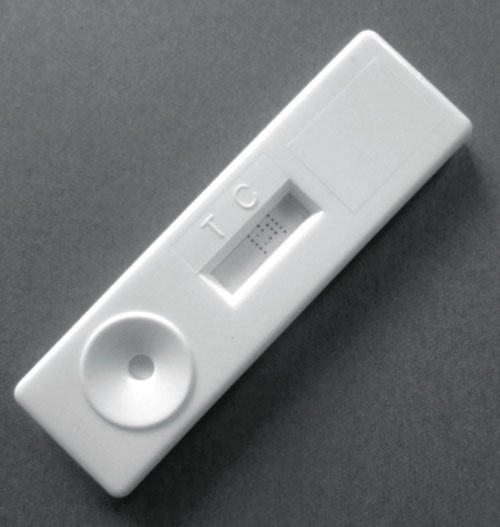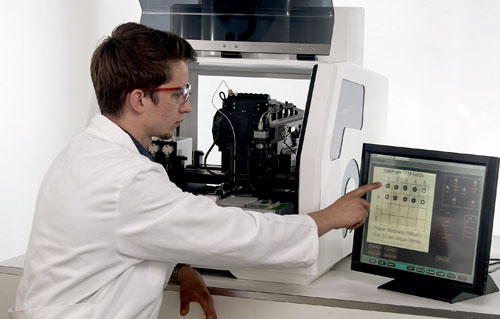January 15, 2016 (Vol. 36, No. 2)
Specialist in Low-Volume Liquid Handling Helps Bring Multiplexing to Lateral Flow and TEM
Scienion is introducing multiplexing to both lateral flow diagnostic rapid tests and transmission electron microscopy (TEM). “No one has done this before,” Claude Dufresne, Ph.D., president, Scienion US, emphasizes.
The company’s deposition techniques enable multiple analytes to be analyzed simultaneously using lateral flow techniques, and up to 100 distinct samples using TEM. Both technologies, until now, were implemented for only single sample analyses.
Scienion’s technologies let researchers extract more information from limited samples and expand the use of expensive assays to more situations cost-effectively without changing instrumentation or workflow.
Lateral Flow Multiplexing
For lateral flow rapid tests, “We can spot 5–10 analytes, in triplicate for proper statistical treatment,” Dr. Dufresne says. “This is a very natural extension of what’s been done on other platforms. ELISA assays, for example, were converted from single parameter analysis in microtiter plates to multiplex versions, enabling researchers to extract more value from sometimes precious patient samples.”
Traditional analyte analysis requires multiple test strips printed with horizontal lines of analytes across the strip. In contrast, Scienion spots arrays of dots, where each dot is analogous to a classical line, explains Dr. Dufresne. This innovation, unlike line printing, exposes each dot to consistent analyte concentrations.
The technology can deposit drops as small as 100 picoliters. For lateral flow rapid tests, spots of about 1 nanoliter can generate good data. Results to be included in an upcoming manuscript show higher limits of detection when compared to classic lines, allowing dozens of analytes to be deposited in the same space, Dr. Dufresne tells GEN. Any limitation, he asserts, is based upon the biology of the immunoassays such as the potential for nonoptimal selectivity.
“We see this as a normal extension of an existing approach,” states Dr. Dufresne. “We are marketing our ability to deliver highly precise ultra-low-volume deposition.”
Scienion also is collaborating with Axxin to develop reader systems for this technology. The reader will enable more exact analysis of multiplexed lateral flow assay data, thereby delivering more value to point-of-care applications. “You can’t rely on the human eye for analysis of such a rich dataset,” Dr. Dufresne cautions.

Scienion’s multiplex lateral flow rapid test helps researchers extract more value from limited samples.
Kits, Consumables, Collaboration
Aside from developing multiplex technology and selling equipment, Scienion also functions as a contract developer and manufacturer, to transfer assays to arrays and produce any type of microarrays. “We’re differentiated by our ability to print high-quality spots and to scale to production levels while maintaining this spot quality,” insists Dr. Dufresne. “Our systems can be incorporated into 24/7 manufacturing lines to produce millions of assays per year.”
Scienion is partnering with Anteo Technologies to develop next-generation microarray consumables with greater benefits for protein microarrays. “We’re exploring surface coatings with Anteo to immobilize proteins of interest for our customers and enhance the binding bioactivity after immobilization,” notes Dr. Dufresne. The first products are expected to be activated glass and polymer slides, as well as microtiter plates.
High-Throughput TEM
High-throughput TEM doesn’t exist yet, Dr. Dufresne says, but it will soon. Scienion’s new sciTEM instrument enables up to 100 picoliter-sized samples to be deposited on a single grid. That advance dramatically lowers the per sample cost of TEM, making this “very useful technique” affordable for many more experiments.
For decades, notes Dr. Dufresne, people placed a single sample on a grid. Placing that sample in the TEM and removing it is a time-consuming process because of the vacuum airlocks the sample passes through. “It typically takes 10–15 minutes each way,” Dr. Dufresne continues. “That limits sample throughput and creates wear and tear on the vacuum system within the microscope.”
Electron microscopy is expensive, so people tend to select only a few samples to analyze. “With our method, they don’t have to choose anymore,” says Dr. Dufresne. “They can put multiple samples on one grid. After inserting the one grid into the TEM microscope, many distinct samples can be evaluated. Applications include nanoparticles analysis and screening for protein buffer conditions. This change in TEM sample preparation will have a tremendous impact on the field.”
Additional applications include filling microwells for in situ TEM and analyzing nanomaterials in solution (liquid cell TEM).

Scienion’s new sciTEM instrument enables up to 100 pico-liter-sized samples to be deposited on a single grid for high-throughput transmission electron microscopy.
Growth through Collaboration
Scienion spun out of the Max Planck Institute for Molecular Genetics in 2001 to develop multiplex assays for diagnostics companies. Since then, it has formed a number of collaborations and partnerships that help it perform more research than would be expected of a company its size. In addition to collaborations with Axxin and Anteo, it has participated in The Seventh Framework and Euramet collaborative research programs.
Such collaborations have fostered advancements, but Dr. Dufresne suggests the core source of innovation comes from working closely with customers to address their needs. “We pay close attention to the challenges our customers face,” he explains. “We have a number of talented engineers in Berlin to address them.”
Underscoring that point, Scienion has twice won the annual “Innovationspreis Berlin-Brandenburg,” awarded by the German states of Berlin and Brandenburg.
The Berlin headquarters is home to R&D, engineering, and instrument assembly. The company opened a U.S. division, Scienion US, in 2011 to better support and develop the North American market. Both sites engage in contract manufacturing. “For North American customers,” observes Dr. Dufresne, “it’s easier to conduct these activities in New Jersey than to send samples to Germany.”
Scienion
Location: Volmerstraße 7b, D-12489 Berlin, Germany
Phone: 49 (0) 30.6392.1700 (Germany), (888) 988-3842 (United States)
Website: www.scienion.com
Principal: Holger Eickhoff, Ph.D., CEO
Number of Employees: 50
Focus: Scienion, a supplier of instrumentation and services for low-volume liquid handling, is transitioning the fields of lateral flow analysis and transmission electron microscopy from single to multiplexed sample analysis.



